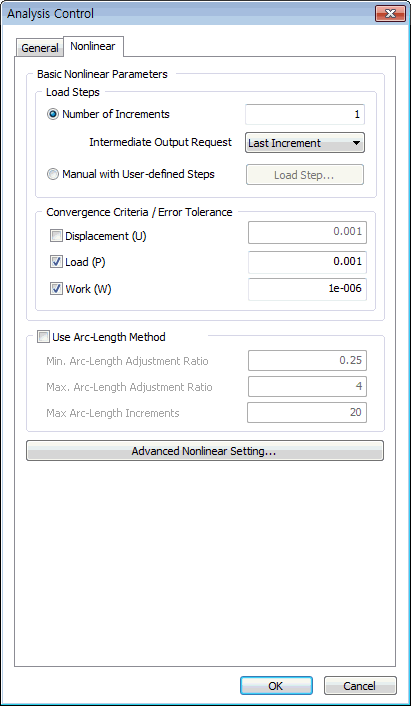ERROR [2103]: FAILED TO CONVERGE IN NONLINEAR ANALYSIS. LOAD INCREMENT=#
Cause
This error is generated when convergence fails at a specific load increment step during a nonlinear analysis, provided that the analysis termination option is turned on. When convergence fails, the nonlinear analysis is terminated.
Failed convergence in nonlinear analysis is typically caused by the following reasons:
1. When the sign of the curvature changes around the solution, the Newton-Raphson method may diverge.

2. When the load control procedure is used to perform an analysis on a model whose stiffness drastically decreases

3. When the mesh becomes severely distorted due to large deformation
Analysis Type
Nonlinear analysis (nonlinear static, nonlinear explicit transient)
Related Menu
Analysis >> Analysis Case >> General >> Analysis Control >> Nonlinear...
Remedy
1. Revise the main parameters for nonlinear analysis such as the number of load increments and convergence criterion to become favorable for convergence in "Analysis >> Analysis Case >> General >> Analysis Control >> Nonlinear...".

2. If the load increment is too large, divide it into a number of load increments using the subcases for each step.
3. Since the displacement control procedure is more stable than the load control procedure in nonlinear analysis, assign forced displacement conditions and perform the analysis with the displacement control procedure. When a forced displacement is applied, the applied load can be calculated by using the reaction force.
4. If the material model is complex, use the Bi-Linear model, which is a typical material model.
5. Examine the shape of the element which results in high stress. Even if the initial shape is good, severe distortion may occur as a result of large deformation. In such a case, modify the mesh to maintain a certain level of mesh quality even after deformation.
6. Re-distribute loads to avoid any unnecessary concentrated local stresses. When a concentrated load is applied to a node, redistribute the load onto an assumed small face as a pressure load.
Typically the remedy numbers 1-3 are investigated first. If the error persists, try the remedy numbers 4-6.